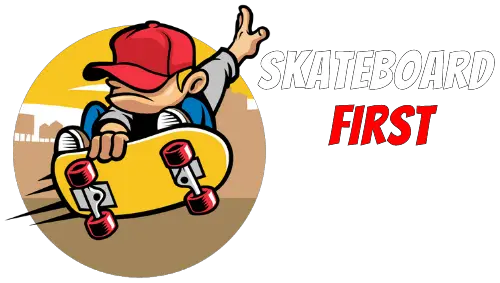Longboarding is a great fun activity. If you are starting, understanding how to longboard entails acquiring a few techniques to ensure your safety and make surfing a seamless and rewarding experience. The abilities you must learn are divided into three groups:
- Early training and preparations
- Basic riding techniques include balancing, gliding, pushing, and halting.
- Intermediate skills involve moving fast, braking with the foot, carving, and crashing.
Part 1: Before you begin longboarding
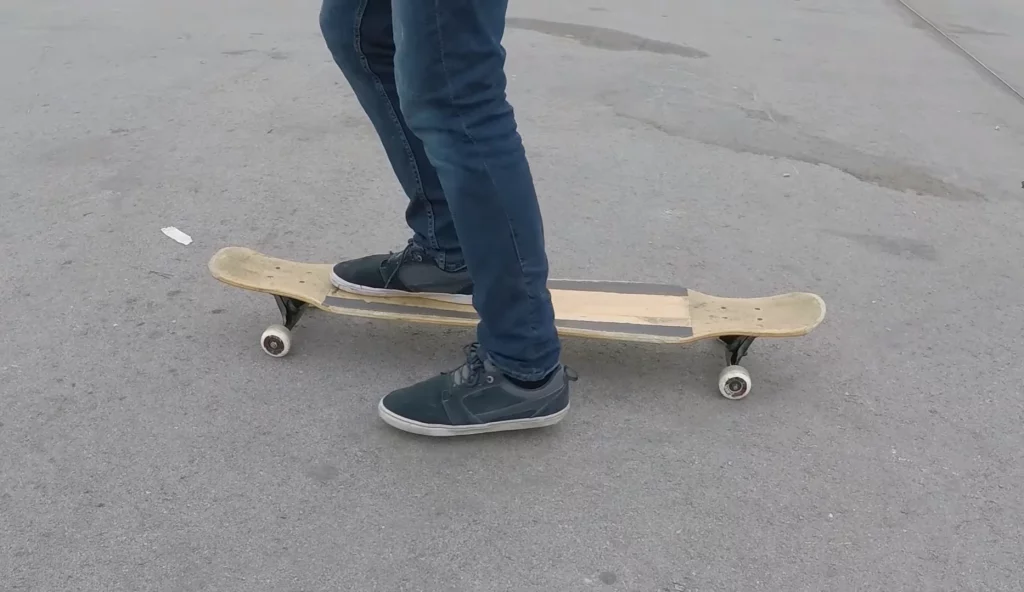
Step 1: Pick the best longboard to start on.
Choosing the best longboard to begin on will go a long way toward helping you learn more rapidly. On the other extreme, you need to have a longboard that is ideal for beginners, and then on the other, you also need something that you can remain to use once you have perfected the activity.
Purchase a low-riding board with a reasonable wheelbase (the space between the trucks) for security and stability. A drop-through or double drop, a drop-through with a drop deck, is your best alternative. Drop-throughs have trucks connected through the deck.
Step 2: Obtain protective equipment
You don’t want to fall off and damage yourself, as this would likely make you give up on attempting to longboard. The wrists, elbows, and knees are the most common locations for beginning longboarders to experience injuries which is why you need to have proper protective gear to practice riding on a smooth surface.
Before getting onto a longboard, put on some sturdy safety gear, including knee pads, elbow pads, slide gloves and wrist guards. You will be glad you did. Additionally, it is recommended that you strap on a helmet before enjoying your first ride in the park or community.
Step 3: Determine your normal posture.
If you’re new to board sports, you may not be conscious of your native stance, which is either a left foot forward (also referred to as a “regular” footer) or a right foot forward (also referred to as a “goofy stance” footer).
Finding out is simple; you are required to stand on the floor with your feet close together and seek a small push forward from somebody positioned behind you. You’ll fall off balance as a result of this and will need to use one foot to stabilize yourself. In your normal posture, your front foot is whatever foot you stop yourself with (left or right).
All board sports, longboarding, snowboarding, surfing, wakeboarding, kiteboarding, etc. are practised with a fairly similar stance by most people. To learn how to longboard, you should go in your natural posture.
Step 4: Work on static balance.
It would be best if you become competent at balancing on your longboard when it is still before you start moving it. The easiest approach to do this is to put your longboard down on grass or a thick patch of carpet so that the wheels won’t roll.
Step onto the longboard after that, and adjust your standing. The optimum balance may be achieved by determining the most comfortable posture, which is normally with your feet approximately shoulder width spread.
The deck sways from side to side as you travel, so even if your tires are stationary, it could be difficult for you to remain on the board. The wheels turn even when not moving when the deck is tilting.
As you become comfortable using your arms and legs on a motionless longboard, hold your knees bent to lower your center of gravity and stabilize yourself using your arms.
Part 2: Fundamental longboard riding techniques
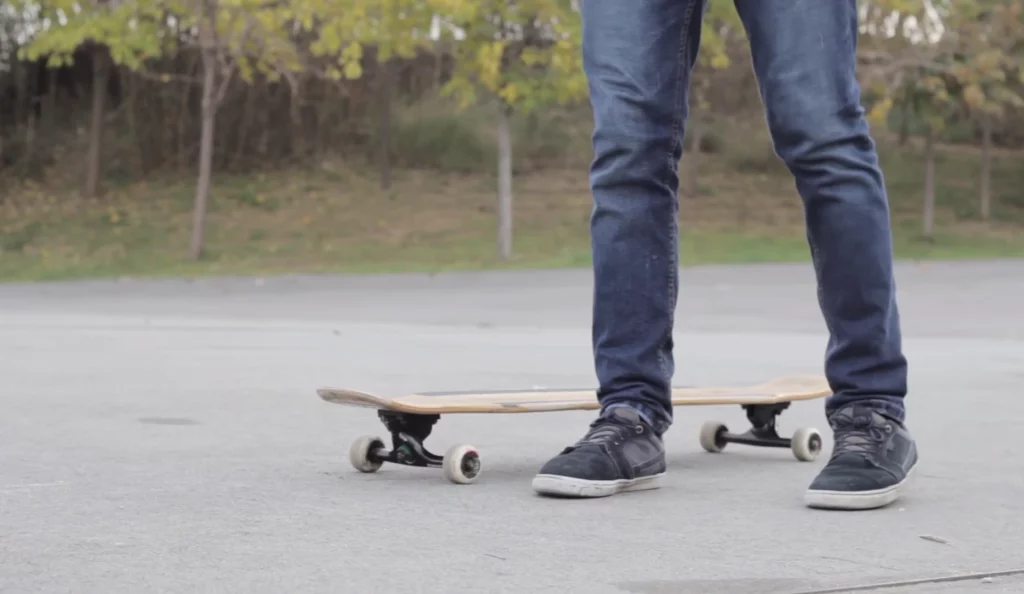
Step 1: Learn how to hop on your longboard.
Your longboard is now ready for you to start rolling. Placing the board on a flat surface, such as a peaceful walkway or a parking lot with a nice surface, is a smart option. Learning how to get onto your board is the foremost thing you ought to do.
Begin by putting one foot on the deck before proceeding to the other. Most people begin by putting their front foot first, with their back foot remaining on the floor (as per their normal posture). Some people seem to prefer stepping on the board with their back foot first. Whichever strategy suits you the most will immediately be apparent to you.
Assuming you put your front foot down first, place it at a 45-degree angle to the deck, near to the front trucks but not completely perpendicular.
After that, while staying stable on your front foot, raise your back foot from the ground and place it roughly a shoulder wide beyond your front foot at an angle of 45° to 90° with the board. Inverse everything if you step off with your rear foot.
Step 2: Master the art of rolling down a gentle incline.
You’re prepared to begin rolling now since you understand how to get onto your longboard. Try to locate a very little slope with smooth pavement, something that you can hold onto before you start to roll (such as a wall, a fence, or even a person!). The incline should be no greater than a few inches.
You’re first holding on to the rail or wall next to you after getting onto your longboard, as outlined in Step 1 of this procedure. Hold the wall when you’re prepared so that you may start rolling slowly. While your tires are moving, sense the movement of the longboard and try to maintain your balance.
To prevent spinning at first:
- Steer upright until you feel at ease with the movement.
- Try not to press with the balls or heels of your foot onto the edges of the deck.
- As you reach the end of the slope, let your longboard gradually lose momentum before jumping off.
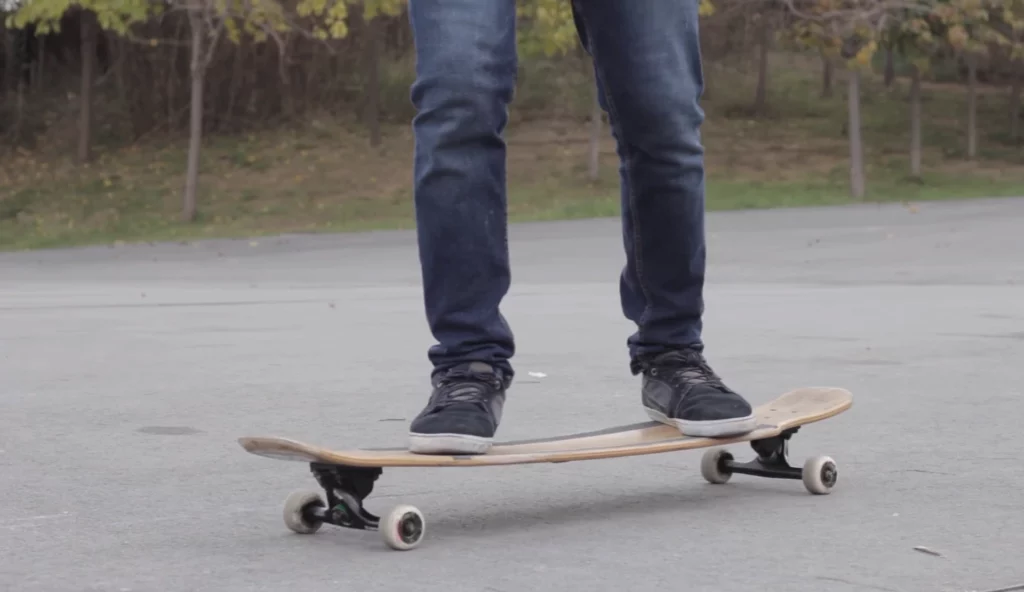
Step 3: Become comfortable pushing your longboard.
Locate a level area with a smooth surface so you can try pushing. Step onto your longboard, withdraw your back foot off the deck, and lower it to the ground while extending your front knee and dropping your hips while remaining stable on your front foot. As you lower your back foot to the ground, rotate your front foot to point forward instead of outwards at a 45-degree angle.
Push in the area of the rear to get the wheels moving after your back foot hits the ground. While standing on your front foot on the deck, stomp it this way or that way several times. Lift your rear foot back off the ground and onto the deck once you’ve regained more speed, then place both feet at a 45-degree angle. Push more speed is what you’re riding your longboard at.
Step 4: Discover a simple method of stopping.
It would be best if you also had a means to stop since the faster you become at pushing, the quicker your longboard will start to roll. Jumping off your longboard and riding it out is the easiest technique for a newbie. If you don’t bike faster than you run, this will only operate in certain situations.
Stepping onto the floor directly in front of your longboard with your rear foot is the most effective technique. This will force the board to stop or slow down when you step off because your front foot will shove the board backwards before it reaches the ground. Your board will certainly continue to roll if you jump off to the edge of it.
If you’re a beginning longboarder, another simple way to halt is to ride on grass or a rough texture. Make sure there aren’t any rocks in the way because they could cause your longboard to stop still and throw you soaring.
Step 5: Develop basic longboard maneuvers
Turning is a vital next step when learning how to longboard like a skateboard. You experimented with turning your wheels by placing your heels and toes on the rails while maintaining balance on a motionless longboard. You are now ready to execute it while rolling.
Deliver your longboard a gentle kick push on a smooth, level surface, as you did in the previous steps. Press your toes solidly on the front edge of your deck as you roll to let your wheels spin (toe edge turn).
If you’re regular, it will guide your board to the right; if you’re goofy, it will guide your board to the left. By moving your body slightly in the line of the turn as you push with your toes, you may add more weight to the rail by placing more pressure on it.
To spin your wheels in the other manner, slowly move your weight from your toes to your heels (heel edge turn). Once more, work on controlling your body weight and force on the rail to create controlled and clean turns.
Part 3: Mastering advanced riding techniques
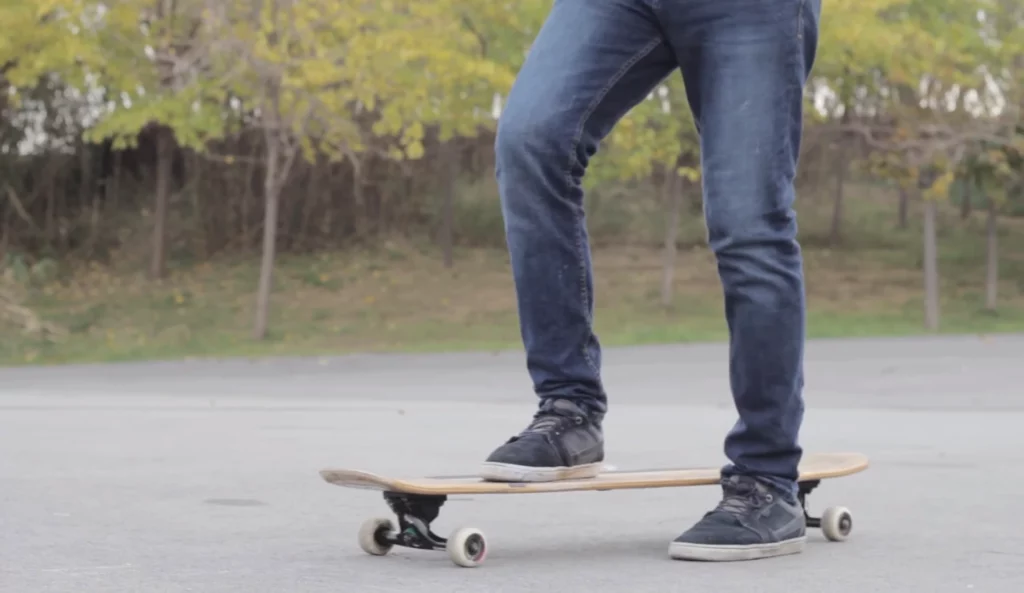
Step 1: Get comfortable riding your longboard quicker.
You are now prepared to ride your longboard faster since you are comfortable at basic speeds. Look for a hill that is soft and calm, one that dips down or straightens out. Get used to riding down that short incline and making tiny toeside and heelside twists as you do so.
Experiment with various stance widths and load distribution on each foot to figure out what works for you. Put additional weight on your foot if you experience speeding flutters, which are short, uncontrollable twists. Continue honing your pushes with whichever foot (front or back) while standing on your driving foot for greater periods on flat ground.
Step 2: Get familiar with longboarding’s foot brakes.
The next task for you is to master the foot brake. Although it may appear simple when seeing expert riders do it, foot braking does take some experience and great technique. The first step in the foot braking technique is comparable to the first in kick pushing.
When travelling at high speeds on a longboard, mastering to slide is typically a safer approach than using the useful foot brake technique at lower velocities.
Step 3: Practice slipping off your longboard.
Learning how to fall is another essential skill for novice longboarders. A broken arm or a broken finger can easily result from the natural motion of protecting oneself when landing with the hands on the ground.
As a result, it’s important to learn how to fall correctly by doing the following: tucking your arms under your upper body, resting on your forearm, and sliding sideways on your shoulders.
Conclusion:
Although longboarding in different riding styles requires practice, the step above will have you pushing and performing freestyle tricks in no time.
Learning how to slide will be your next step once you have mastered the fundamental abilities, enabling you to improve your longboarding capabilities.
Hi, I am Mian. I am the Owner and Founder Of Skateboard First. I am such a huge fan of skateboarding, and I am here to enhance your experience in skateboarding.
